Welcome to Aynajian Group
Research in Aynajian Group is focused on emerging phenomena in correlated and topological quantum matter at the nanoscale using spectroscopy techniques complemented with machine learning for big data analysis, theory, and computation.
Aynajian Group uses ultra-high vacuum, variable temperature scanning tunneling microscopy and spectroscopy to visualize electrons at the nanoscale. In addition, the group carries out novel neutron and x-ray scattering techniques at dedicated research facilities around the world to gain insights of the electronic properties and their excitations.
The Aynajian Group closely collaborates with theory, computation, and material synthesis groups within and outside the department.
Funding:
NSF CAREER: Visualizing Emergent Electronic States Near Quantum Phase Transitions
NSF DMR Visualizing the bulk-boundary correspondence in antiferromagnetic topological matter
Research Areas
Topological materials represent a captivating frontier in condensed matter physics, offering a paradigm shift in our understanding of electronic properties and opening up unprecedented opportunities for technological advancement. These materials possess unique characteristics derived from their nontrivial topology, which gives rise to robust and exotic electronic modes at their boundaries that are protected by the bulk band topology (bulk-boundary correspondence).
Among the diverse classes of topological materials, magnetic topological semimetals and insulators with higher-order topology (HOT) stand out as a particularly intriguing subset that constitute a distinctive new family of topological phases of matter. HOT materials support topological states on their higher-dimensional boundaries (1D edges and 0D corners). By combining higher order topology and intrinsic magnetism, antiferromagnetic topological quantum materials exhibit a rich array of topologically non-trivial phenomena including the quantum anomalous Hall effect (QAHE) and the Axion insulator state.
We study the effect of correlation and non-trivial topology in quantum materials from unconventional superconductors to topological insulators.
-
Correlated Superconductors
In conventional superconductors, electron-phonon interaction leads to the pairing of electrons at low temperatures. The result is a superconductor with a relatively low Tc of the order of 1 - 20 K. The BCS theory gives a good description of the properties of these so called conventional superconductors.
The BCS theory and the basic understanding of superconductivity, however, fail in describing the physics in the high temperature superconductors and similar material systems such as the cuprates, heavy fermions and Fe-pnictides. They have kept physicist fascinated and ambitious to understand their microscopic mechanism and find routs toward room temperature superconductors for over two decades.
In these material systems, superconductivity is only one piece of a rather large puzzle. Strong electronic correlations lead to the emergence of a variety of exotic quantum states of matter with broken-symmetry at low temperatures, which coexist, compete, or are intertwined with superconductivity.
Central to all unconventional superconductors is the antiferromagnetic parent compound out of which the various quantum states of matter such as superconductivity, electronic nematic, charge density wave and the enigmatic pseudogap emerge.
Using variable-temperature scanning tunneling microscopy and spectroscopy, we are able to visualize these exotic electronic states and investigate their interplay at the nanoscale.
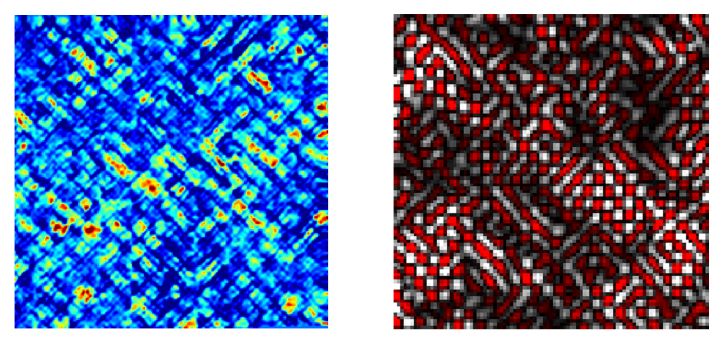
-
Quantum phase transitions
A local magnetic moment is formed when a strongly interacting quantum state, such as an atomic f orbital, cannot be doubly occupied owing to strong on-site Coulomb repulsion. Below a characteristic temperature TK, known as the Kondo temperature, these local moments are magnetically screened by the conduction electrons forming a narrow band of heavy fermions. Depending on the strength of this interaction, competing antiferromagnetic and heavy Fermi liquid ground states develop, separated by an extended quantum critical region.
Spectroscopically, the quantum critical region remains largely unexplored, primarily due to the high energy resolution required to probe the rather narrow heavy states near the Fermi energy (EF). Using scanning tunneling spectroscopy, we have demonstrated that the f-electron spectral function and signatures of quantum criticality can be probed in heavy fermion materials.
This opens a route to investigate the physics of quantum criticality at the nanoscale.
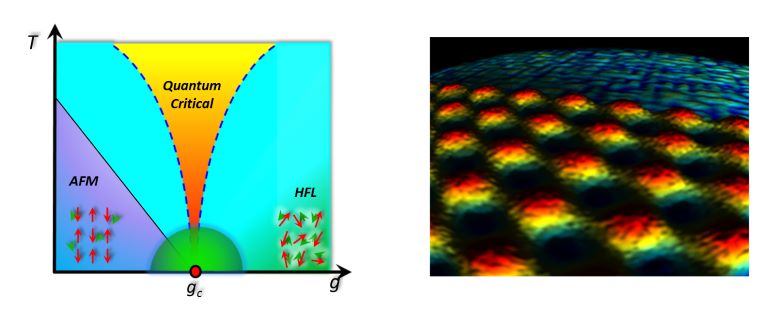
Experimental Facilities
-
Scanning tunneling microscopy and spectroscopy
Optical microscopes magnify visible light reflected from a specimen. With the wavelength of visible light being on the order of 103nm, optical microscopes become worthless when trying to visualize atoms... or perhaps electrons.
Scanning tunneling microscopy (STM) uses quantum mechanical tunneling to image a samples surface with subatomic spatial resolution. In a STM, a sharp metallic tip, made out of tungsten or platinum-iridium is brought to close proximity to a sample's surface - close enough for the tip's and sample's electronic wave functions to overlap. That's a distance of 4-6 Å.
Scanning the tip across the sample at a constant tunneling current (by adjusting the tip height with a feedback loop at a constant set-point bias voltage) yields a topographic image corresponding to the integrated local density of states. At any location on the sample's surface, adjusting the tip height and measuring the differential conductance as a function of tip-sample bias voltage yields a spectrum proportional to the local electronic density of states. Vast information of the electronic band structure and ordering phenomena can be obtained through spectroscopic imaging with the STM. These measurements combine the topographic imaging with the local spectroscopy at each pixel. Maintaining a tunneling junction at a few Angstroms over the course of several days, which is the time required to complete such a map, demand serious instrumental stability.
Our variable-temperature ultra-high vacuum STM is capable of reaching temperatures from as low as 2K to room temperature. To isolate electric and acoustic noise, the STM is placed in the basement of Science-II building in an acoustic and radio frequency shielded room. The microscope head is further suspended from springs to reach the optimized instrumental stability.
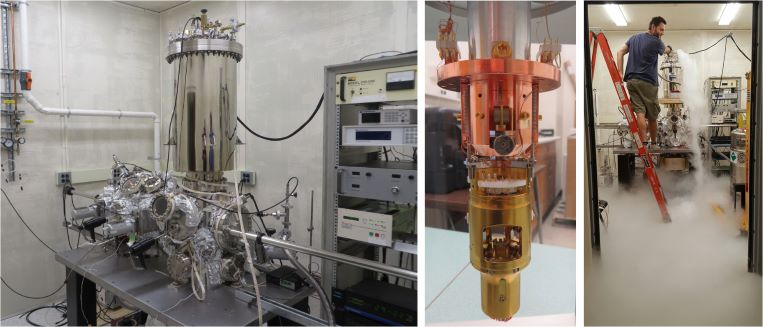
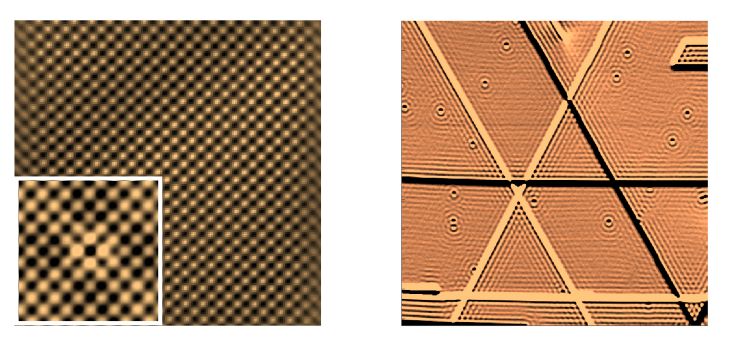
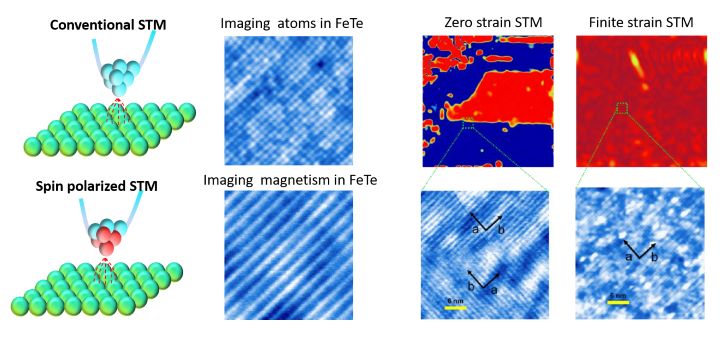
-
X-ray and neutron scattering
Complementary to the STM, scattering techniques, such as neutron and x-ray spectroscopy, have the capability to probe the bulk static and fluctuating spin and charge excitation spectra.
In a scattering experiment, an incident beam with a specific energy,momentum, and polarization is scattered off a sample and collected at a detector with a final energy, momentum and polarisation. For elastic scattering processes, where the initial final energies are the same, information of the crystal structure as well as static magnetic and charge ordering with specific momentum transfer can be obtained. Inelastic scattering probes their collective excitations, such as phonons and magnons.
Of particular interest is the resonant x-ray scattering (RXS), where the incident photon energy is tuned to a specific atomic edge. RXS offers a unique element and orbital specific probe and has been successfully used recently for probing magnetic, charge and orbital ordering in correlated electron systems.
Our group carries out neutron and x-ray scattering experiments in dedicated research facilities around the world.
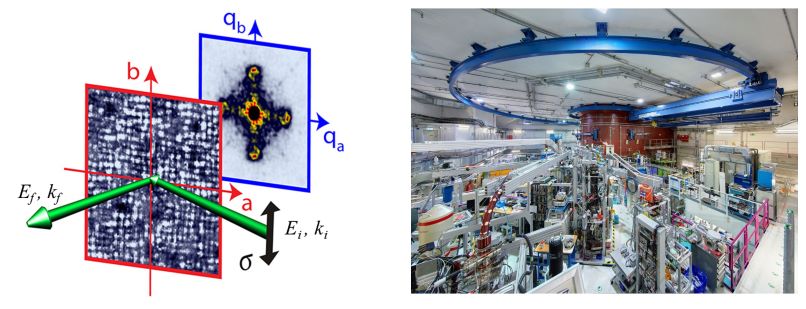
Publications
-
Preprints
Surface state evolution induced by magnetic order
Mingda Gong, Divyanshi Sar, Joel Friedman, Dariusz Kaczorowski, S. Abdel Razek, Wei-Cheng Lee, and Pegor Aynajian
submitted
-
Books
Electron-phonon interaction in conventional and unconventional superconductors
Pegor Aynajian
Springer Theses - Recognizing Outstanding Ph.D. Research,Springer, 1st Edition (2011)
-
2022
Surface state evolution induced by magnetic order in axion insulator candidate EuIn2As2
Mingda Gong, Divyanshi Sar, Joel Friedman, Dariusz Kaczorowski, S. Abdel Razek, Wei-Cheng Lee, Pegor Aynajian
Phys. Rev. B 106, 125156 (2022)Coexisting Kondo hybridization and itinerant f-electron ferromagnetism in UGe2
Ioannis Giannakis, Divyanshi Sar, Joel Friedman, Chang-Jong Kang, Marc Janoschek, Pinaki Das, Eric D. Bauer, Gabriel Kotliar, and Pegor Aynajian
Phys. Rev. Research 4, L022030 (2022) -
2021
Inhomogeneous Kondo-lattice in geometrically frustrated Pr2Ir2O7
Mariam Kavai, Joel Friedman, Kyle Sherman, Mingda Gong, Ioannis Giannakis, Samad Hajinazar, Haoyu Hu, Sarah E. Grefe, Justin Leshen, Qiu Yang, Satoru Nakatsuji, Aleksey N. Kolmogorov, Qimiao Si, Michael Lawler, and Pegor Aynajian
-
2020
Physicists hunt for room-temperature superconductors that could revolutionize the world’s energy system
Pegor Aynajian
-
2019
Orbital-selective Kondo-lattice and enigmatic f-quasiparticles emerging from inside the antiferromagnetic phase of a heavy fermion
Ioannis Giannakis, Justin Leshen, Mariam Kavai, Sheng Ran, Chang-Jong Kang, Shanta R. Saha, Y. Zhao, Z. Xu, J. W. Lynn, Lin Miao, L. Andrew Wray, Gabriel Kotliar, Nicholas P. Butch, and Pegor Aynajian
Science Advances 5, no. 10, eaaw9061 (2019)
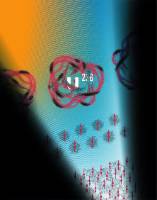
Image by Gokhan A Ersan
High temperature singlet-based magnetism from Hund's rule correlations
Lin Miao, Rourav Basak, Sheng Ran, Yishuai Xu, Erica Kotta, Haowei He, Jonathan D. Denlinger, Yi-De Chuang, Y. Zhao, Z. Xu, J. W. Lynn, J. R. Jeffries, S. R. Saha, Ioannis Giannakis, Pegor Aynajian, Chang-Jong Kang, Yilin Wang, Gabriel Kotliar, Nicholas P. Butch, L. Andrew Wray
Nature Communications 10, 644 (2019)
Emergent charge order near the doping-induced Mott-insulating quantum phase transition in Sr3Ru2O7
Justin Leshen, Mariam Kavai, Ioannis Giannakis, Yoshio Kaneko, Yoshi Tokura, Shantanu Mukherjee, Wei-Cheng Lee, and Pegor Aynajian
Communications Physics - nature 2, 36 (2019)
Visualizing uniaxial-strain manipulation of antiferromagnetic domains in FeTe using spin-polarized scanning tunneling microscope
Mariam Kavai, Ioannis Giannakis, Justin Leshen, Joel Friedman, Paweł Zajdel, and Pegor Aynajian
-
2018
Visualizing Heavy Fermion Confinement and Pauli Limited Superconductivity in Layered CeCoIn5
A. Gyenis, B. Feldman, M. Randeria, G. Peterson, E. Bauer, P. Aynajian and A. Yazdani
-
2016
Quasi-particle interference of heavy fermions in resonant x-ray scattering
A. Gyenis, E. H. da Silva Neto, R. Sutarto, E. Schierle, F. He, E. Weschke, M. Kavai, R. E. Baumbach, J. D. Thompson, E. D. Bauer, Z. Fisk, A. Damascelli, A. Yazdani, and P. Aynajian
Science Advances 2, e1601086 (2016)
Spectroscopic Imaging of Strongly Correlated Electronic States
Ali Yazdani, Eduardo H. da Silva Neto, and Pegor Aynajian
-
2014
Visualizing Heavy Fermion Formation and their Unconventional Superconductivity in f-electron Materials
Pegor Aynajian, Eduardo H. da Silva Neto, Brian Zhou, Shashank Misra, Ryan E. Baumbach, Zachary Fisk, John Mydosh, Joe D. Thompson, Eric D. Bauer, and Ali Yazdani,
J. Phys. Soc. Jpn. Special Topics 83, 061008 (2014)
Ubiquitous Interplay between Charge Ordering and High-Temperature Superconductivity in Cuprates
Eduardo H. da Silva Neto, Pegor Aynajian, Alex Frano, Riccardo Comin, Enrico Schierle, Eugen Weschke, András Gyenis, Jinsheng Wen, John Schneeloch, Zhijun Xu, Shimpei Ono, Genda Gu, Mathieu Le Tacon, Ali Yazdani
-
2013
Visualizing nodal heavy fermion superconductivity in CeCoIn5
Brian B. Zhou, Shashank Misra, Eduardo H. da Silva Neto, Pegor Aynajian, Ryan E. Baumbach, J. D. Thompson, Eric D. Bauer, and Ali Yazdani,
Detection of electronic nematicity using scanning tunneling microscopy
Eduardo H. da Silva Neto, Pegor Aynajian, Ryan E. Baumbach, Eric D. Bauer, John Mydosh, Shimpei Ono, Ali Yazdani
Phys. Rev. B 87, 161117(R) (2013)
-
2012
Visualizing heavy fermions emerging in a quantum critical Kondo lattice
Pegor Aynajian, Eduardo da Silva Neto, András Gyenis, Ryan E. Baumbach, J. D. Thompson, Zachary Fisk, Eric D. Bauer, and Ali Yazdani
Detecting incipient stripe order in the high-temperature superconductor Bi2Sr2CaCu2O8+x
Eduardo da Silva Neto, Pegor Aynajian, Colin V. Parker, and Ali Yazdani
Scattering from incipient stripe order in the high-temperature superconductor Bi2Sr2CaCu2O8+d
Eduardo da Silva Neto, Colin V. Parker, Pegor Aynajian, Aakash Pushp, Jinsheng Wen, Zhijun Xu, Genda Gu, and Ali Yazdani
-
2010
Fluctuating stripes at the onset of the pseudogap in the high-Tc superconductor Bi2Sr2CaCu2O8+x
Colin V. Parker, Pegor Aynajian, Eduardo H. da Silva Neto, Aakash Pushp, Shimpei Ono, Jinsheng Wen, Zhijun Xu, Genda Gu, and Ali Yazdani
Visualizing the formation of the Kondo lattice and the hidden order in URu2Si2
Pegor Aynajian, Eduardo da Silva Neto, Colin V. Parker, Yingkai Huang, Abhay Pasupathy, John Mydosh, and Ali Yazdani
-
2008
Energy gaps and Kohn anomalies in elemental superconductors
Pegor Aynajian, T. Keller, L. Boeri, S. M. Shapiro, K. Habicht, B. Keimer,
-
2007
The Triple Axis Spin-Echo Spectrometer TRISP at the FRM II
T. Keller, Pegor Aynajian, S. Bayrakci, K. Buchner, K. Habicht, H. Klann, M. Ohl, B. Keimer
-
2006
Momentum-resolved electron-phonon interaction in lead determined by neutron resonance spin-echo spectroscopy
T. Keller, Pegor Aynajian, K. Habicht, L. Boeri, S.K. Bose, and B. Keimer,
Group Members
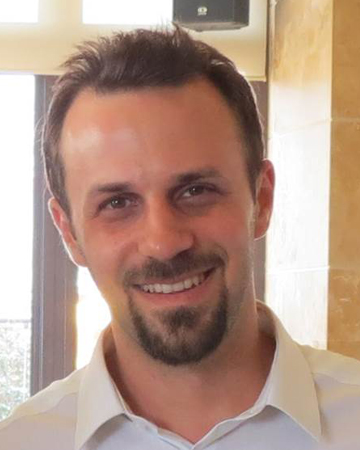
Pegor Aynajian
Associate Professor
Graduate Students
Current:
- Joel Friedman (jfried29 at binghamton.edu)
- Mingda Gong (mgong2 at binghamton.edu )
- Divyanshi Sar (dsar1 at binghamton.edu)
- Luka Khizanishvili (lkhizan1 at binghamton.edu )
Alumni:
-
Justin Leshen
- Mariam Kavai
- Ioannis Giannakis
Contact Info
Pegor Aynajian
aynajian at binghamton.edu
4400 Vestal Parkway East
Binghamton, NY 13902